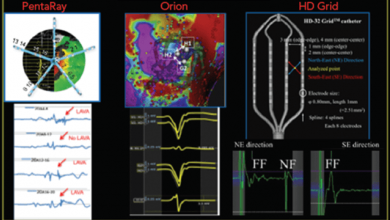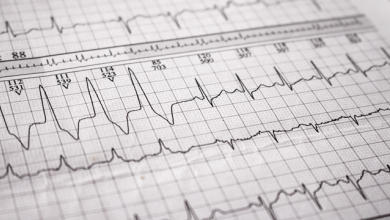Search results
Author(s):
Benjamin Berte
,
Katja Zeppenfeld
,
Roderick Tung
Added:
3 years ago
Accurate substrate characterisation is important for depicting scar-related re-entrant tachycardia to optimise ablation targets and strategies. The underlying substrate can be analysed using electrogram (EGM) characteristics, such as low voltage, local abnormal voltage activity (LAVA), evoked potentials or late potentials, conduction analysis in sinus rhythm or differential pacing, or using…
View more
Author(s):
John M Miller
Added:
3 years ago
The Electrocardiogram
In the entire realm of his work, Dr Josephson’s greatest love was the simple electrocardiogram (ECG). His discernment, based on the ECG, into the patient’s history and disease processes was legendary. Among the more important and insightful contributions he made to our understanding of heart disease and arrhythmias from the ECG are: observations of alternating preexcitation…
View more
Author(s):
Francis E Marchlinski
Added:
3 years ago
Catheter-based Mapping to Characterise Ventricular Tachycardia
Catheter-based mapping of the left ventricle (LV) to characterise the substrate and origin of ventricular tachycardia (VT) was thought to involve a much greater level of risk and therefore not to be pursued. Mark proved the naysayers wrong with his careful and methodical approach to evaluating the LV endocardium.
What made these…
View more
Author(s):
Mario Njeim
,
Frank Bogun
Added:
3 years ago
Percutaneous ablation for ventricular tachycardia (VT) was first attempted in 1983 and has rapidly evolved to become an important option for controlling recurrent VTs.1 Endocardial ablation remained the only percutaneous approach until epicardial access was introduced by Sosa et al. in 1996 and thereafter became progressively more available as an adjunctive strategy for the treatment of…
View more
Author(s):
Chen Wei
,
Pierre Qian
,
Usha B Tedrow
,
et al
Added:
3 years ago
Ventricular tachycardia (VT) is a life-threatening sequela found in patients with cardiomyopathy. ICDs can terminate ventricular arrhythmias, but recurrent device shocks lead to reduced quality of life and are associated with higher mortality.1–5 Radiofrequency catheter ablation has emerged as an effective treatment for VT refractory to anti-arrhythmic therapy and has also been shown to reduce…
View more
Author(s):
Demosthenes G Katritsis
,
Josep Brugada
Added:
3 years ago
The term narrow QRS tachycardia indicates individuals with a QRS duration ≤120 ms, while wide QRS tachycardia refers to tachycardia with a QRS duration >120 ms.1 Narrow QRS complexes are due to rapid activation of the ventricles via the His–Purkinje system, suggesting that the origin of the arrhythmia is above or within the His bundle. However, early activation of the His bundle can also occur…
View more
Author(s):
Raphael K Sung
,
Penelope A Boyden
,
Satoshi Higuchi
,
et al
Added:
2 years ago
Author(s):
Tom Nelson
,
Pankaj Garg
,
Richard H Clayton
,
et al
Added:
3 years ago
Ventricular tachycardia (VT) and VF occur mainly in people with impaired cardiac function and/or ischaemic heart disease, and account for the majority of sudden cardiac deaths worldwide.1 Treatment with anti-arrhythmic drugs such as amiodarone may be at best neutral in terms of mortality and carries significant long-term risks.2,3 While ICDs significantly improve survival for patients with…
View more
Author(s):
Demosthenes G Katritsis
Added:
3 years ago
The most important papers on arrhythmias and electrophysiology published in 2018, selected by the editors of Arrhythmia and Electrophysiology Review(AER).
Clinical Practice
Marrouche NF, Brachmann J, Andresen D, et al. Catheter ablation for atrial fibrillation with heart failure. N Engl J Med 2018;1;378:417–27.
Crossref | PubMed
Packer DL, Mark DB, Robb RA, et al. Effect of catheter…
View more
Author(s):
Saagar Mahida
,
Benjamin Berte
,
Seigo Yamashita
,
et al
Added:
3 years ago
Since the first catheter ablation for cardiac arrhythmia more than three decades ago, ablation technology has continually evolved at a rapid pace. Much of the early progress in the field was made in ablation of supraventricular tachycardias. Following a seminal study from Haïssaguerre et al.1 in 1998, which demonstrated that pulmonary vein triggers are important sources of atrial fibrillation (AF…
View more













 « First
« First